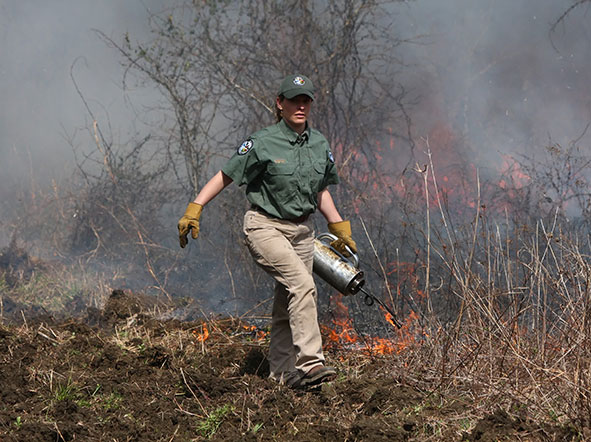Cool Season Plants
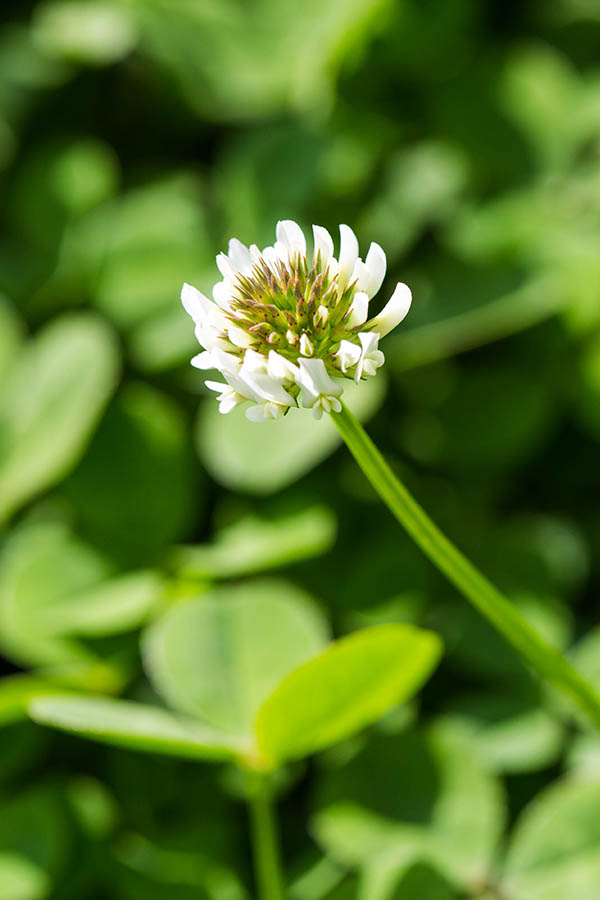
White Clover
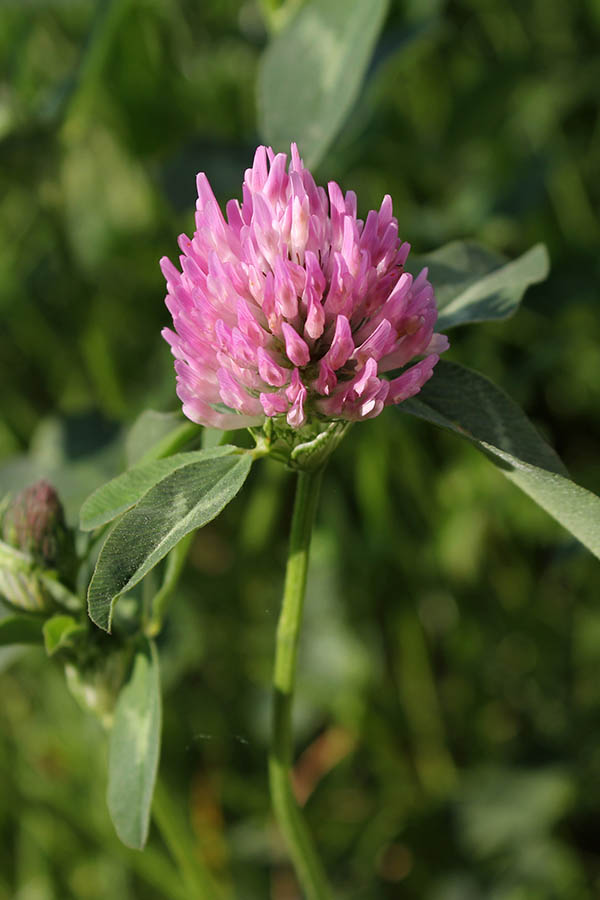
Red Clover
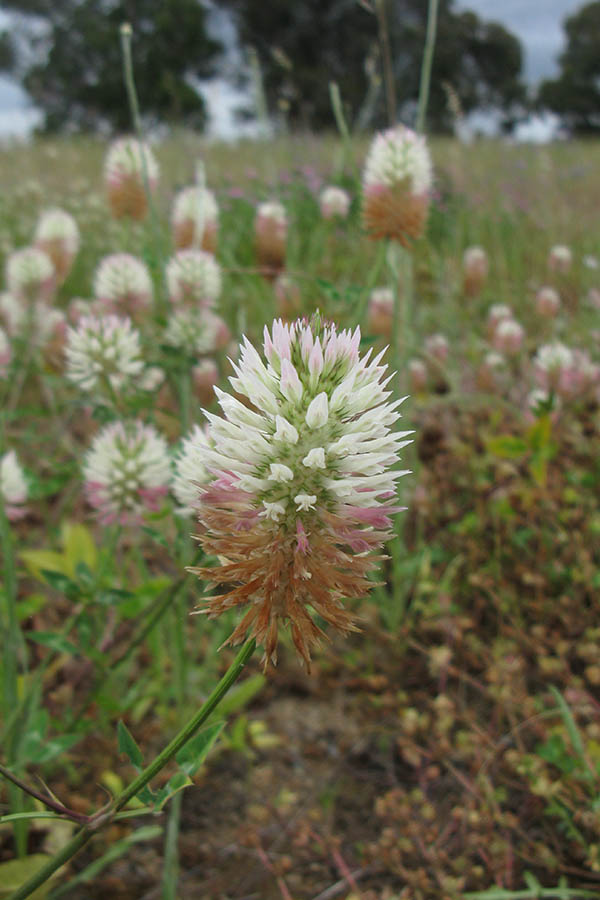
Arrowleaf Clover
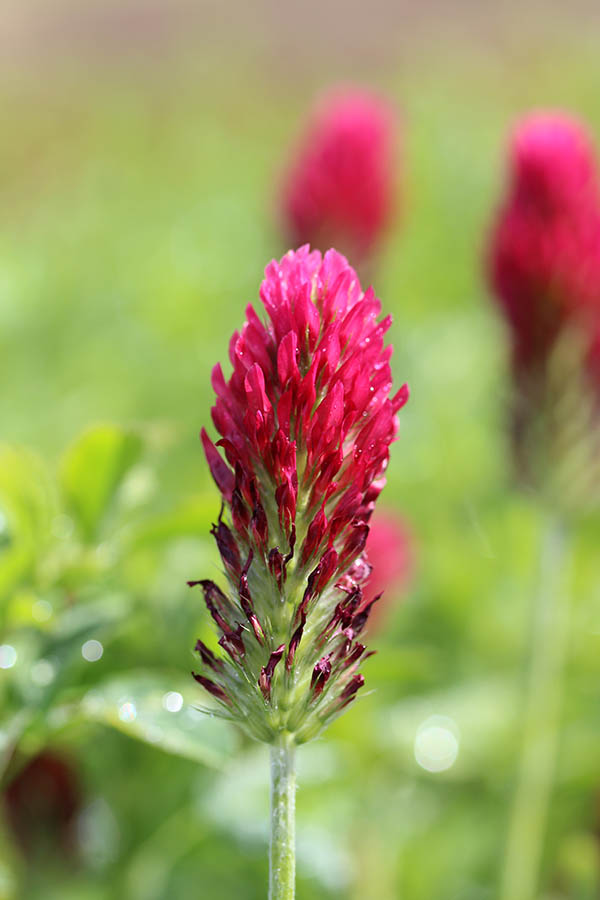
Crimson Clover
Grasses & Grains

Oats (Avena sativa)
- Description: A cool-season, annual small grain that is less cold tolerant than wheat and rye but provides preferred early fall forage.
- Soil Adaptation: Adapted to well-drained, light-textured soils (sandy loam to clay).
- Planting Dates: August 15 through October 15
- Soil pH Range: 5.8 to 6.5
- Fertilization: Apply fertilizer according to soil test recommendations, or apply 100 lbs/ac of 8-24-24 at time of planting and 100 lbs/ac of 34-0-0, 30 days postemergence.
- Soil Preparation: Plant in a well-prepared, firm seedbed.
- Planting Rates: Drill 90 lbs/ac; broadcast 120 lbs/ac. Cover seed 1 inch deep.
- Varieties: Arkansas 604 & 833, Buck Forage, Buck Magnet, Chapman, Coker, Dallas, Florida 501, Harrison, Horizon 314, Rogers, TAM 606
- Companion Plants: Austrian winter peas, clovers, vetch, rye, triticale, and wheat.
- Management: Apply an additional 150 lbs/ac of 34-0-0 in February if you want a seed crop.
- Recommended Herbicides: A postemergent application of 2,4-D (1 to 3 pts/ac) or Harmony Extra XP (0.3 to 0.6-fl. oz/ac) or Banvel (1 pt/ac) can be used to control undesirable broadleaf plants.

Wheat (Triticum aestivum)
- Description: A cool-season, annual small grain, that deer browse heavily all winter.
- Soil Adaptation: Adapted to well-drained to moist soils (sandy loam to clay). Tolerates poor drainage.
- Planting Dates: August 15 through October 15. See management suggestions.
- Soil pH Range: 5.8 to 6.5
- Fertilization: Apply fertilizer according to soil test recommendations, or apply 100 lbs/ac of 8-24-24 at time of planting and 100 lbs/ac of 34-0-0, 30 days postemergence.
- Soil Preparation: Plant in a well-prepared, firm seedbed.
- Planting Rates: Drill 90 lbs/ac; broadcast 120 lbs/ac. Cover seed 1 inch deep.
- Varieties: Commercial forage varieties, Longhorn, Lockett, GA Gore, Saluda
- Companion Plants: Austrian winter peas, clovers, vetch, oats, and rye.
- Management: Deer palatability is often reduced if vegetation reaches 9 to 12 inches in height in late winter or spring. Mowing at this time can often increase palatability and use but also reduces seed production. MOWING MAY NOT BE NECESSARY IF YOU PLANT WHEAT AFTER SEPTEMBER 15. If you want seed production, do not mow, but apply an additional 150 lbs/ac of 34-0-0 in February.
- Recommended Herbicides: A postemergent application of 2, 4-D (1 to 3 pts/ac) or Harmony Extra XP (0.3 to 0.6-fl. oz/ac) or Banvel (1 pt/ac) can be used to control undesirable broadleaf plants. Where annual ryegrass is a problem weed, we recommend a postemergent application fo Finesse (0.75 to 0.9-fl. oz/ac), Powerflex (3.5-fl. oz/ac), Osprey (4.75-fl. oz/ac), or Hoelon (7-fl. oz/ac). DO NOT APPLY HERBICIDES WHEN YOU USE WHEAT IN SEED MIXTURES WITH LEGUMES OR BRASSICAS UNLESS RECOMMENDED ON SPECIMEN LABEL.

Rye (Secale cereale)
- Description: A cool-season, annual small grain (similar to wheat) with good cold tolerance. Rye grows very fast and loses its protein levels early. Do not confuse rye with ryegrass!
- Soil Adaptation: Adapted to well-drained soils (sandy loam to clay).
- Planting Dates: August 15 through October 15
- Soil pH Range: 5.8 to through 6.5
- Fertilization: Apply fertilizer according to soil test recommendations, or apply 100 lbs/ac of 8-24-24 at time of planting and 100 lbs/ac of 34-0-0, 30 days postemergence.
- Soil Preparation: Plant in a well-prepared, firm seedbed.
- Planting Rates: Drill 90 lbs/ac; broadcast 120 lbs/ac. Cover seed 1/2 to 1 inch deep.
- Varieties: Elbon, Wrens Abruzzi, Wondergraze, Vitagraze, Wintergrazer 70, Maton, Bates
- Companion Plants: Austrian winter peas, clovers, vetch, oats, and wheat.
- Management: Deer palatability is often reduced if vegetation reaches 9 to 12 inches in height in late winter or spring. Mowing at this time can increase palatability and use but reduces seed prooduction. If you want seed production, do not mow, but apply an additional 150 lbs/ac of 34-0-0 in February.
- Recommended Herbicides: A postemergent application of 2,4-D (1 to 3 pts/ac) or Harmony Extra XP (0.3 to 0.6-fl. oz/ac) or Banvel (1 pt/ac) can be used to control undesirable broadleaf plants.

Triticale (Triticosecale spp.)
- Description: A cool-season, annual small grain that is a hybrid cross of rye and wheat.
- Soil Adaptation: Adapted to well-drained, moist soils (sandy loam to clay).
- Planting Dates: August 15 through October 15
- Soil pH Range: 5.8 to 6.5
- Fertilization: Apply fertilizer according to soil test recommendations, or apply 100 lbs/ac of 8-24-24 at time of planting and 100 lbs/ac of 34-0-0, 30 days postemergence.
- Soil Preparation: Plant in a well-prepared, firm seedbed.
- Planting Rates: Drill 90 lbs/ac; broadcast 120 lbs/ac. Cover seed 1 inch deep.
- Varieties: Tamcale 5019, Beagle 82, Trical 102 & 336
- Companion Plants: Austrian winter peas, clovers, vetch, and oats.
- Management: Apply an additional 150 lbs/ac of 34-0-0 in February if you want a seed crop.
- Recommended Herbicides: A postemergent application of 2,4-D (1 to 3 pts/ac) or Harmony Extra XP (0.3 to 0.6-fl. oz/ac) or Banvel (1 pt/ac) can be used to control undesirable broadleaf plants.
Legumes (inoculate legumes with bacterium)

Alfalfa (Medicago sativa)
- Description: A cool-season, perennial legume widely used by deer, rabbits, and turkey in the spring through fall. Provides seeds, insects, and foliage for turkeys and is used some by quail. It is the most expensive and labor intensive supplemental food planting.
- Soil Adaptation: Adapted to well-drained, fertile loams; somewhat drought tolerant.
- Planting Dates: September 1 through October 15
- Soil pH Range: 6.5 to 7.5
- Fertilization: Apply fertilizer according to soil test recommendations, or apply 150 lbs/ac of 0-46-0 and 250 lbs/ac of 0-0-60 at time of planting.
- Soil Preparation: Plant in a well-prepared, firm seedbed that is within the proper pH range.
- Planting Rates: Drill 15 lbs/ac; broadcast 20 lbs/ac. Cover seed 1/4 - 1/2 inch deep.
- Varieties: Alfagraze, Amerigraze 401 & 702, Ameristand, Bulldog 505
- Inoculant Strain: A
- Companion Plants: None; grows best alone.
- Management: When grazing pressure is not adequate, occasional mowing and removal of clippings from the plot are necessary. Mow in spring and late summer to keep shots green and tender. Apply 100 lbs/ac of 0-46-0 and 150 lbs/ac 0-0-60 annually after the first mowing. Alfalfa has a high requirement for the micronutrient boron, and an application of 20 lbs/ac of 10 MOL Borax every three years is usually necessary to meet these requirements. Alfalfa is susceptible to insect damage from alfalfa weevils, leafhoppers, armyworms and nermatodes. Closely monitor plots for insect damage and treat quickly if signs appear. Use Pounce (6 to 12-fl. oz/ac) or Mustang (4-fl. oz/ac) to control alfalfa weevils and leafhoppers. Soil test annually to monitor pH and large potassium requirements.
- Recommended Herbicides: See ladino white clover.

Austrian Winter Peas (Pisum sativum)
- Description: A cool-season, annual legume. Produce from fall to spring, providing foliage for deer and turkeys. Grows well in grass mixes. Seeds mature from May and June.
- Soil Adaptation: Adapted to loam to clay soils, well-drained to moist.
- Planting Dates: September 1 through November 1
- Soil pH Range: 5.6 to 7.0
- Fertilization: Apply fertilizer according to soil test recommendations, or use 100 lbs/ac of 0-20-20 at time of planting. Note: P and K levels have to be low to warrant a fertilizer application.
- Soil Preparation: Plant in a well-prepared, firm seedbed.
- Planting Rates: Drill 30 lbs/ac; broadcast 40 lbs/ac. Cover seed 1 inch deep.
- Varieties: Granger, Fenn, Melrose
- Inoculant Strain: C
- Companion Plants: Cool-season annual grasses
- Management: Mowing followed by disking in August can help reseed plantings.
- Recommended Herbicides: None

Vetch (Vicia spp.)
- Description: A cool-season, annual legume that vines or trails. Grows rapidly in late winter and early spring but does not provide fall forage. Deer and rabbits heavily browse foliage. Provides foliage for turkeys, and quail and turkeys eat the seeds. Its foliage attracts insects and creates bugging areas for quail and turkeys if stands are not too thick. NOT TO BE CONFUSED WITH CROWN VETCH, A PERENNIAL LEGUME AND LESS DESIRABLE WILDLIFE FORAGE.
- Soil Adaptation: Adapted to well-drained, medium textured soils. Tolerates acid soils.
- Planting Dates: September 1 through October 15
- Soil pH Range: 5.4 to 6.8
- Fertilization: Apply fertilizer according to soil test recommendations, or apply 150 lbs/ac of 0-20-20 at time of planting.
- Soil Preparation: Plant in a well-prepared, firm seedbed.
- Planting Rates: Drill 20 lbs/ac; broadcast 30 lbs/ac. Cover seed 1 inch deep.
- Varieties: Bigflower Vetch (most preferred by deer); Hairy Vetch-Madison, Auburn Americus, Oregon, Lana, Common Vetch-AU Olympic, Williamette.
- Inoculate Strain: C
- Companion Plants: Cool-Season annual grasses and clover.
- Management: To enhance reseeding, disk plot every third year in August and apply 150 lbs/ac of 0-20-20 yearly, as needed to assist with reseeding and increase stand vigor.
- Recommended Herbicides: None
Clovers

Arrowleaf (Trifolium vesiculosum)
- Description: A cool-season, reseeding, annual legume. During spring, plants grow to heights of 40 to 50 inches under optimal conditions. Seeds mature from late June through early August. Arrowleaf clover is less palatable than some of the other clovers but still provides good forage for deer.
- Soil Adaptation: Adapted to well-drained sandy loams to light clay soils.
- Planting Dates: September 1 through October 15
- Soil pH Range: 5.8 to 6.8
- Fertilization: Apply fertilizer according to soil test recommendations, or apply 250 lbs/ac of 0-20-20 in the fall of the next calendar year after establishment.
- Soil Preparation: Plant in a well-prepared, firm seedbed.
- Planting Rates: Drill 10 lbs/ac; broadcast 15 lbs/ac. Cover seed 1/4 inch deep.
- Varieties: Meechee, Yuchi, Amclo, Apache
- Inoculant Strain: O
- Companion Plants: Cool-season annual grasses, crimson clover.
- Management: Reseeding may be encouraged by mowing and/or light disking in October, followed by an application of 250 lbs/ac of 0-20-20.
- Recommended Herbicides: A postemergent application of Select 2EC (8-fl. oz/ac + 1% crop oil), or Poast Plus (2 pts/ac + 1% crop oil) can be used to control undesirable grasses. Two applications 3 to 4 weeks apart may be necessary.

Crimson (Trifolium incaratum)
- Description: A cool-season, annual legume that can grow as high as 2 feet. Because it grows quicker and seeds out earlier than most clovers, you may use it in combination with other clovers. Crimson clover provides late-winter/early spring forage for deer.
- Soil Adaptation: Adapted to well-drained sandy loams to heavy clays; moderately shade tolerant of acidic soils.
- Planting Dates: September 1 through October 15
- Soil pH Range: 5.5 to 7.5
- Fertilization: Apply fertilizer according to soil test recommendations, or apply 200 lbs/ac of 0-20-20 postemergence.
- Soil Preparation: Plant in a well-prepared, firm seedbed.
- Planting Rates: Drill 20 lbs/ac; broadcast 30 lbs/ac. Cover seed 1/4 inch deep.
- Varieties: Auburn, Autauga, Chief, Dixie, Talladega, Tibbee
- Inoculant Strain: R
- Companion Plants: Austrian winter peas, cool-season annual grass, other annual clovers, and vetch.
- Management: Crimson clover is a strong reseeder and may be enhanced by mowing and/or light disking in September. Follow with an application of 150 lbs/ac of 0-20-20 after disturbance.
- Recommended Herbicides: A postemergent application of Select 2EC (8-fl. oz/ac + 1% crop oil), or Poast Plus (2 pts/ac + 1% crop oil) can be used to control undesirable grasses. Two applications 3 to 4 weeks apart may be necessary.

Red (Trifolium hirtum)
- Description: A cool season, short-lived perennial legume that provides preferred forage for deer, rabbits, and turkeys. Produces March through July; this late production provides excellent insect bugging areas and brood habitat for turkey and quail.
- Soil Adaptation: Adapted to sandy loam to upland clay soils; moderately drought tolerant.
- Planting Dates: September 1 through October 15
- Soil pH Range: 5.8 to 7.0
- Fertilization: Apply fertilizer according to soil test recommendations, or apply 200 lbs/ac of 0-20-20 at time of planting.
- Soil Preparation: Plant in a well-prepared, firm seedbed.
- Planting Rates: Drill 8 lbs/ac; broadcast 12 lbs/ac. Cover seed 1/4 inch deep.
- Varieties: Kenland, Redland Max, Redland Graze, Redland III, Bulldog, Kenstar
- Inoculant Strain: B
- Companion Plants: Grows best alone, but you can plant it in mixes with cool-season annual grasses and ladino white clover.
- Management: Mow and/or lightly disk in October every two years and fertilize with 0-20-20 at the rate of 150 lbs/ac.
- Recommended Herbicides: A postemergent application of Select 2EC (8-fl. oz/ac + 1% crop oil), or Poast Plus (2 pts/ac + 1% crop oil) can be used to control undesirable grasses. Two applications 3 to 4 weeks apart may be necessary.

White (Trifolium repens)
- Description: A cool-season, short-lived perennial legume that is highly productive and low-maintenance. A great clover for providing quality deer forage most of the year. Forage production is lowest during late summer. Produces well from October through June.
- Soil Adaptation: Adapted to silty loam to fertile clay soils; mildly shade tolerant poor drainage.
- Planting Dates: September 1 through October 15
- Soil pH Range: 5.5 to 7.0
- Fertilization: Apply fertilizer according to soil test recommendations, or apply 200 lbs/ac of 0-20-20 at time of planting.
- Soil Preparation: Plant in a well-prepared, firm seedbed.
- Planting Rates: Drill 4 lbs/ac; broadcast 5 lbs/ac. Cover seed 1/2 inch deep.
- Varieties: Osceola, Regal, Louisiana S-1, Patriot, Durana, Regalgraze
- Inoculant Strain: B
- Companion Plants: Cool-season annual grasses and red clover. High production varieties should be planted alone.
- Management: Reseeding can often be enhances by light disking and/or mowing in September and applying 150 lbs/ac of 0-20-20. Grass control is often required in spring.
- Recommended Herbicides: A postemergent application of Select 2EC (8-fl. oz/ac + 1% crop oil), or Poast Plus (2 pts/ac + 1% crop oil) can be used to control undesirable grasses. Two or more applications 3 to 4 weeks apart may be necessary. BERMUDAGRASS: Apply Select 2EC in the fall to control burmudagrass. Another option is to kill the entire plot with multiple glyphosate applications; cultivate using deep tillage, and replant the following year. APPLICATION TIMING IS VERY IMPORTANT IN CONTROLLING PERENNIAL GRASSES. Postemergence applications of Pursuit (4-fl. oz/ac) or Butyrac 200 (1-2 qt/ac) are recommended to control some broadleaf weeds. When applied in late spring, Pursuit provides some preemergence control of undesirable grasses, such as foxtail, johnsongrass, and crabgrass. Where horse nettle is a problem, we recommend spot applications of Grazon or Surmount. DO NOT USE AS A BROADCAST APPLICATION; both Grazon and Surmount KILL CLOVERS.

Ball (Trifolium nigrescens)
- Description: A rapidly growing, cool-season, annual legume that grows on sites not suitable for other clovers.
- Soil Adaptation: Adapted to sandy loams and clay loam soils; tolerates poor drainage and acidic soils.
- Planting Dates: September 1 through October 15
- Soil pH Range: 5.5 to 7.0
- Fertilization: Apply fertilizer according to soil test recommendations, or apply 250 lbs/ac of 0-20-20 in the fall of the next calendar year after establishment.
- Soil Preparation: Plant in a well-prepared, firm seedbed.
- Planting Rates: Drill 2 lbs/ac; broadcast 3 lbs/ac. Cover seed 1/4 inch deep.
- Inoculant Strain: B
- Companion Plants: Oats and wheat.
- Management: Encourage reseeding by mowing and/or light disking in September followed by applying 250 lbs/ac of 0-20-20.
- Recommended Herbicides: A postemergent application of Select 2EC (8-fl. oz/ac + 1% crop oil), or Poast Plus (2 pts/ac + 1% crop oil) can be used to control undesirable grasses. Two applications 3 to 4 weeks apart may be necessary.

Subterranean (Trifolium subterranum)
- Description: A cool-season, annual legume that mistakes excellent plots in short-rotation pine and provides forage for deer, rabbits, and turkeys. Subterranean Clover is NOT a strong fail or winter producer. Most production occurs from March through May. This production window provides excellent bugging opportunities for quail and turkeys.
- Soil Adaptation: Adapted to sandy to loam soils; good shade tolerance.
- Planting Dates: August 15 through October 15
- Soil pH Range: 5.8 to 7.0
- Fertilization: Apply fertilizer according to soil test recommendations, or apply 200 lbs/ac of 0-20-20 postemergence.
- Soil Preparation: Plant in a well-prepared, firm seedbed.
- Planting Rates: Drill 15 lbs/ac; broadcast 20 lbs/ac. Cover seed 1/4 inch deep.
- Varieties: Mt. Barker, Woogenellup, Daliak, Clare, Nuba, Nungarin
- Inoculant Strain: WR
- Companion Plants: Cool-season annual grasses and vetch.
- Management: Encourage reseeding by mowing and/or fall disking and fertilizing with 0-20-20 at a rate of 200 lbs/ac.
- Recommended Herbicides: A postemergent application of Select 2EC (8-fl. oz/ac + 1% crop oil), or Poast Plus (2 pts/ac + 1% crop oil) can be used to control undesirable grasses. Two applications 3 to 4 weeks apart may be necessary.
Other

Forage Chicory (Cichorium intybus)
- Description: A perennial herb and member of the lettuce family that can produce high yields. Forage chicory is planted in the fall, develops a few leaves at ground level during winter and in spring, begins rapid growth until it blooms in late summer. Newly planted forage chicory plots can produce for 3 years.
- Soil Adaptation: Adapted to wide range of soil types and moderately drought tolerant.
- Planting Dates: September 1 through October 15
- Soil pH Range: 5.5 to 7.0
- Fertilization: Apply fertilizer according to soil test recommendations, or apply 100 lbs/ac of 15-15-15 at time of planting.
- Soil Preparation: Plant in a well-prepared, firm seedbed.
- Planting Rates: Drill 2 lbs/ac; broadcast 4 lbs/ac. Cover seed 1/4-1/2 inch deep.
- Varieties: Choice, Punice, Puna II, Brow Tyne, Six Point, Oasis
- Companion Plants: Oats, wheat, and clovers (crimson, ladino, or red).
- Management: When stand declines, reseed. Applying 100 lbs/ac of 34-0-0 in March increases palatability, nutrition, and production.
- Recommended Herbicides: A postemergent application of Poast Plus (0.5 to 1.5 pts/ac) can be used to control undesirable grasses. A preemerge application of Treflan (1 to 2 pts/ac incorporated into the soil) may be used to control undesirable grasses and broadleaf plants.

Brassicas (Brassica spp.)
- Description: A group of erect, cool-season annuals (greens). Although nutritionally comparable to other forages, studies have shown deer often prefer Brassicas less than other cool season forages.
- Soil Adaptation: Adapted to a wide range of soil types.
- Planting Dates: September 1 through October 15
- Soil pH Range: 5.5 to 7.0
- Fertilization: Apply fertilizer according to soil test recommendations, or apply 100 lbs/ac of 15-15-15 at time of planting.
- Soil Preparation: Plant in a well-prepared, firm seedbed.
- Planting Rates: Drill 5 lbs/ac; broadcast 10 lbs/ac. Cover seed 1/4-1/2 inch deep.
- Varieties: Available varieties of Rape, Kale, Turnip, Canola
- Companion Plants: Best planned alone, but can be mixed with cool-season annual grasses and/or Austrian winter peas.
- Management: Brassicas are good reseeders, and disking in August can increase their reseeding ability. Applying 100 lbs/ac of 34-0-0 in February increases nutrition and subsequent use.
- Recommended Herbicides: A postemergent application of Poast Plus (0.5 to 1.5 pts/ac) can be used to control undesirable grasses. A preemerge application of Treflan (1 to 2 pts/ac incorporated into the soil) may be used to control undesirable grasses and broadleaf plants.
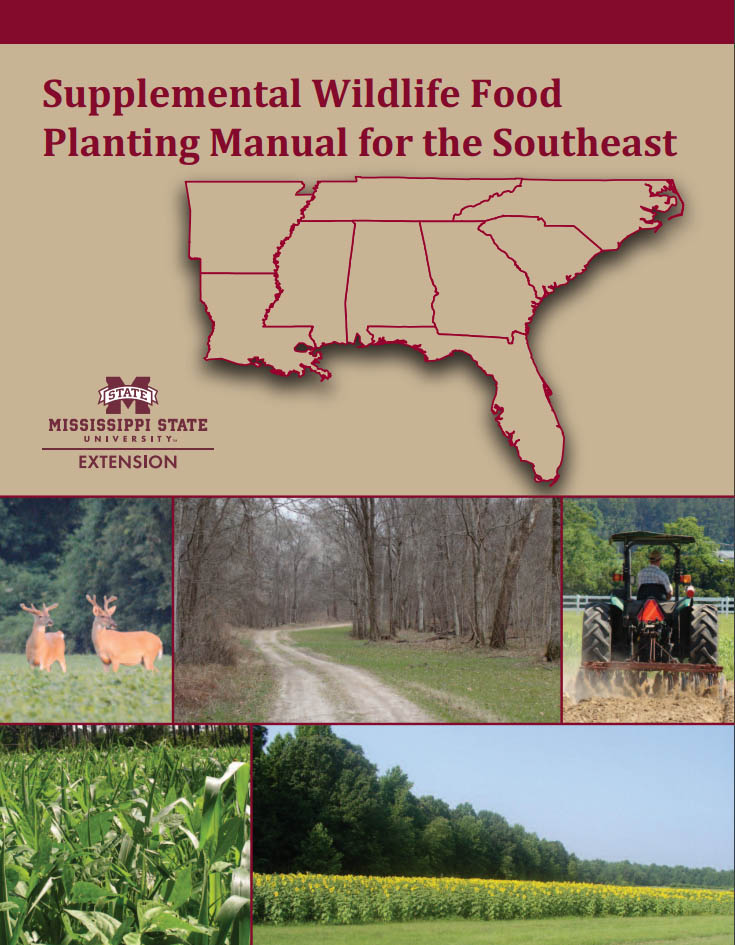
Supplemental Wildlife Food Planting Manual for the Southeast
For more information about these plants including seeding rates, legume inoculants, and herbicide and fertilizer recommendations, please follow this link to the publication Supplemental Wildlife Food Planting Manual for the Southeast.



